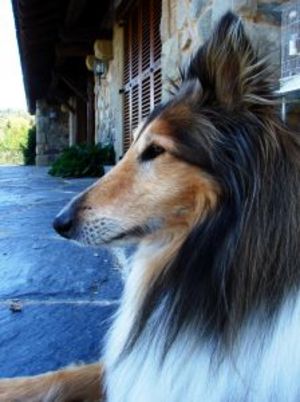Lisa panicked when the vet mentioned lupus after evaluating her five-year-old Collie. However, she calmed down once the doctor explained that the dog had discoid lupus, a fairly benign form when compared to the type of lupus that affects the entire body.
What is Discoid Lupus in Dogs?
This disorder is considered a localized form of lupus, a type of autoimmune disease, according to PetPlace.com. Experts consider it possibly related to the systemic form of the illness. The dog’s immune system for some unknown reason begins to attack the animal’s body. While they haven’t been able to pinpoint the cause or causes of this disorder, researchers believe there is probably some sort of genetic basis for discoid lupus in dogs.
Unlike the systemic version of lupus, which affects the dog’s whole body, the discoid form mainly affects the nose and face. The disease is particularly prevalent in German Shepherds, Collies, Brittany Spaniels, Shetland Sheepdogs, Siberian Huskies and German Shorthaired Pointer breeds, Vetinfo reports.
Signs and Symptoms
The first sign of discoid lupus that owners typically notice in their dogs is a loss of pigmentation around the nose. A nose that’s normally black appears gray. As the condition progresses, it destroys tissue. For dogs with the most advanced cases, ulcerations, crusts or scabs are common.
The severity of the illness varies greatly among dogs. While some dogs have a relatively mild course of disease, with ups and downs, others experience destruction of a portion of the nose.
The dog’s loss of pigment puts the pet at risk for sunburn. Some eventually face an elevated risk of squamous cell carcinoma, a type of skin cancer. Ultraviolet light in general appears to make sores worsen, making the illness seem seasonal to some owners. The incidence is greatest in areas at high altitudes, where dogs experience increased exposure to ultraviolet light.
Diagnosis and Treatment
After taking a medical history and performing an exam, a veterinarian who suspects discoid lupus in a dog will recommend a biopsy. During this procedure, the vet removes a small piece of skin and stitches the area. Since the surgical site is the face, some type of sedation is usually required to make the dog sleepy and to reduce discomfort.
The appropriate treatment for discoid lupus in dogs depends on the severity of each case. For some pets, avoiding the sun is the only treatment necessary to control the disorder. In others, the dog responds to topical treatment with a corticosteroid ointment like Panalog or Synalar.
While some vets recommend using Vitamin E supplements for mild cases, this treatment often takes several months before owners notice any improvement. Using a combination of tetracycline and niacinamide helps some dogs with mild to moderate disease.
When a pet has severe disease, treatment with immunosuppressive drugs such as azathioprine (brand name: Imuran) might be required. Both systemic steroids and immunosuppressants can cause a number of potentially serious side effects, so dogs taking them must be carefully monitored.
Although there is no prevention for discoid lupus in dogs, owners should avoid exposing their pets to sun, especially if the dog is one of the breeds at elevated risk for this disorder. These dogs should remain indoors during the middle of the day. An owner can provide additional protection by applying waterproof sunscreen to the dog’s nose.
Sources:
http://www.petplace.com/dogs/discoid-lupus/page1.aspx
http://www.vetinfo.com/dencyclopedia/delupusdisc.html





